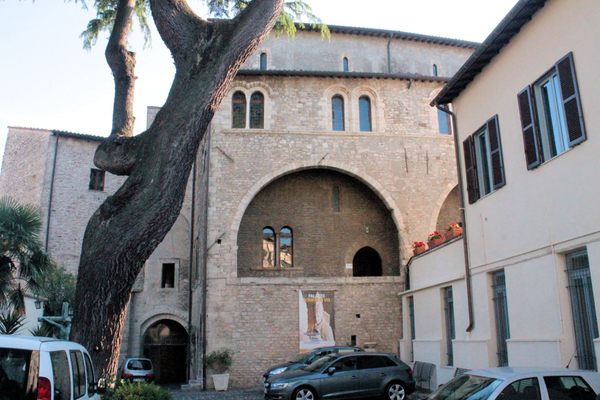Cripta di San Magno
The “Sistine Chapel” of the Middle Ages merges 11th-century science and religion in wondrous hues.
An extraordinary example of Italian medieval religious art lies hidden in the historic town of Anagni, located about an hour southeast of Rome. Also known as the City of Popes (four Popes hailed from the town), Anagni is crowned by its beautiful Romanesque cathedral dating back to the turn of the 11th and 12th centuries.
Under the cathedral floor, the magnificent crypt of Saint Magnus provides an extraordinary example of 13th century medieval religious art with its different cycles and representations decorating a space that measures over 500 square meters. It comprises three naves, three apses, and 21 painted vaults.
Three craftsmen known as the “masters of Anagni” are believed to have been responsible for the different cycles, which represent the story of man’s salvation from creation to the end of time, with apocalyptic overtones and several walls are adorned with stories of local saints and martyrs. All of the scenes are presented in vivid and exceptionally preserved hues and shadows with clear influence from both Rome and southern Italy (Norman Sicily). They would have been admired by medieval pilgrims visiting the crypt to revere the relics of the city’s saints. For some art historians, the craftsmen introduced a new innovative style that contributed to the transition from the style that was influenced by Byzantine art to the early art of the Roman and Tuscan schools. The craftsmen are also believed to have painted the splendid Gothic Hall, in the Monastery of Santi Quattro Coronati in Rome.
Among the many scenes and elements, those presenting the union between science and religion are among the most valuable. The ancient Greek scholars Hippocrates and Galen are depicted as they describe Plato’s elements (as described in his work Timaeus), which, in turn are depicted as spheres with their respective weights and position one above another. Another powerful representation is that of man as a microcosm at the center of the world. The central figure of man is surrounded by concentric circles linking man’s cycles with nature: the ages, the humors, the seasons, and the elements.
Another scene presents the four Tetramorphs—beings made of four parts (man, eagle, bull and lion)—a reference to the prophet Ezekiel and the Apocalypse.
A long sequence of frescoes is dedicated to the story of the Arch and to other biblical stories while the main apse depicts the Apocalypse and the story of the relics of Saint Magnus, the Cathedral’s patron saint. Notice the lamb in the center with seven horns (all-powerful) and seven eyes (all-seeing). Cosmatesque marble floors from the 13th century decorate both the crypt and the church.
Near the crypt, you can also visit the Oratory of Saint Thomas Becket. The 12th century pictorial cycles are not as well preserved and mostly depict stories from the Old and New Testament and the story of Becket’s life and deeds. Interestingly, the shape of the oratory seems to indicate its earlier use as a temple to Mithras, a mithraeum.
According to local stories, Saint Magnus appeared in a dream to the person responsible for the construction of the cathedral, the bishop Pietro da Salerno, urging him to complete the construction of this holy site and the miraculous story of the construction of the Cathedral is also preserved in the local legend associated with the bull and wolf relief. This relief is located on the upper right of the main door: when stones were being extracted from a nearby quarry, a hungry wolf killed one of the two bulls who were used to transport the stones to the construction site. Bishop Peter then ordered the wolf to take the missing bull’s place and the Cathedral was completed in due time.
Know Before You Go
To visit the Crypt you must purchase a ticket for the Museum of the Cathedral, which from is open between November and March from 9 a.m. to 1 p.m. and 3 p.m. to 6 p.m.; and between April and October from 9 a.m. to 1 p.m. and 3 p.m. to 7 p.m.





















Follow us on Twitter to get the latest on the world's hidden wonders.
Like us on Facebook to get the latest on the world's hidden wonders.
Follow us on Twitter Like us on Facebook